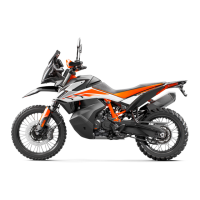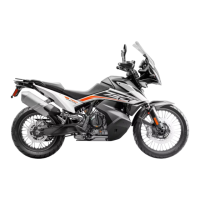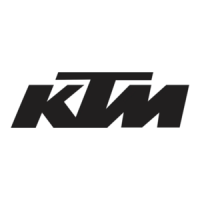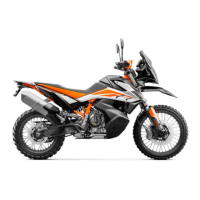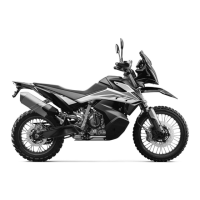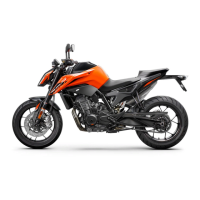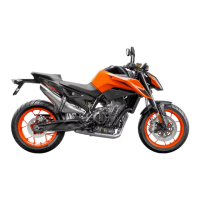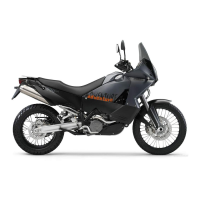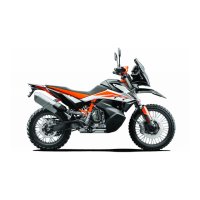
 Loading...
Loading...
Do you have a question about the KTM 790 Adventure 2019 and is the answer not in the manual?
| Displacement | 799 cc |
|---|---|
| Transmission | 6-speed |
| Fuel Tank Capacity | 20 liters |
| Weight | 189 kg (dry) |
| Rear Suspension | WP monoshock |
| Rear Brake | 260 mm disc, 2-piston caliper |
| Ground Clearance | 233 mm |
| Instrumentation | TFT display |
| Starter | Electric |
| Fuel System | Electronic Fuel Injection |
| Engine Type | Liquid-cooled, 4-stroke, parallel twin |
| Power | 95 hp (70 kW) @ 8, 000 rpm |
| Torque | 88 Nm |
| Seat Height | 850 mm |
| Front Suspension | WP USD Ø 43 mm |
| ABS | Bosch 9.1 MP |
| Riding Modes | Street, Offroad |
| Frame | Chromium-Molybdenum-Steel frame |
| Front Brake | 2 x 320 mm discs, 4-piston calipers |
| Wheelbase | 1, 509 mm (59.4 in) |
| Traction Control | MTC (Motorcycle Traction Control), disengageable |
Explains the meaning of specific symbols used in the manual for clarity.
Details typographical formats used in the document for consistent understanding.
Defines the vehicle's designed purpose and limitations for safe operation.
Explains danger, warning, and caution symbols for risk identification.
Warns against modifications to the noise control system and related legal prohibitions.
Provides essential guidelines for safe riding and vehicle operation.
Emphasizes the importance of wearing appropriate protective clothing for rider safety.
Highlights the importance of reading the manual for operation and protection.
Details warranty coverage and conditions for authorized KTM workshop services.
Provides guidelines for the proper use of fuels and auxiliary substances.
Recommends approved parts and accessories for safety and performance.
Prerequisites for perfect operation and prevention of premature wear.
Illustrates key components of the motorcycle from the front left perspective.
Illustrates key components of the motorcycle from the rear right perspective.
Location of the unique VIN stamped on the motorcycle's frame.
Location of the engine number stamped on the engine case.
Information on locating the key number for spare key ordering.
Describes the location and function of the clutch lever.
Details the location and operation of the hand brake lever.
Explains the location and function of the throttle grip.
Overview of switches located on the left handlebar grip.
Operation of the combined emergency stop and starter button.
Explains the function of the ignition and steering lock mechanism.
Procedure for safely opening the fuel tank filler cap.
Details the function and safety coupling of the side stand.
Overview of the instrument cluster's function areas and displays.
Explains the meaning and display of various warning indicators.
Details the function and meaning of various indicator lamps.
Explains the fuel level indicator and its behavior.
Guide to navigating and operating the vehicle's menu system.
Details the KTM MY RIDE system for connectivity and configuration.
Explains the display of navigation information and its configuration.
Information on the Tire Pressure Monitoring System and its warnings.
Describes the different selectable ride modes and their performance characteristics.
Instructions for adjusting the front rider's seat position.
Details the handlebar mounting points and adjustment options.
Procedure for adjusting the clutch lever position for comfort.
Procedure for adjusting the foot brake lever position for comfort.
Procedure for adjusting the shift lever position for optimal ergonomics.
Essential steps and safety advice before the first ride.
Guidelines for the engine break-in period to ensure longevity.
Instructions and warnings regarding vehicle loading and weight limits.
Pre-ride checks to ensure the vehicle is roadworthy and safe.
Step-by-step procedure for starting the motorcycle engine.
Guidance on gear shifting and general riding techniques.
Instructions and safety warnings for effective braking.
Guidelines and safety precautions for refueling the motorcycle.
Lists mandatory maintenance tasks and their intervals.
Lists recommended maintenance tasks for optimal performance.
Instructions for adjusting the rear shock absorber's spring preload.
Procedure for removing the passenger seat.
Procedure for installing the passenger seat.
Procedure for removing the front rider's seat.
Procedure for installing the front rider's seat.
Steps for cleaning the motorcycle's drive chain.
Procedure for adjusting the drive chain tension.
Procedure for removing the left side fairing panel.
Procedure for installing the left side fairing panel.
Procedure for removing the battery cover.
Procedure for installing the battery cover.
Procedure for removing the front fender.
Instructions for cleaning fork dust boots to maintain seal integrity.
Procedure for removing the motorcycle's windshield.
Procedure for installing the motorcycle's windshield.
Procedure for removing the engine guard.
Procedure for installing the engine guard.
Explanation of the ABS system, its components, and operation.
Procedure for checking brake disc wear and condition.
Steps to check the front brake fluid level.
Procedure for checking front brake lining thickness and condition.
Steps to check the rear brake fluid level.
Procedure for checking rear brake lining thickness and condition.
Step-by-step guide for removing the front wheel.
Step-by-step guide for installing the front wheel.
Step-by-step guide for removing the rear wheel.
Step-by-step guide for installing the rear wheel.
Guidance on inspecting tires for wear, damage, and cuts.
Instructions for checking and setting correct tire pressure.
Information on the function and operation of daytime running lights.
Procedure for safely removing the 12-V battery.
Procedure for safely installing the 12-V battery.
Instructions for charging the 12-V battery.
Steps for replacing the main fuse to restore electrical system function.
Procedure for replacing fuses related to the ABS system.
Guide to checking and verifying the correct headlight beam aim.
Instructions for adjusting the headlight beam range for different conditions.
Procedure for checking the coolant level in the expansion tank.
Instructions for adding or adjusting coolant to the correct level.
Explanation of selectable ride modes and their performance characteristics.
Details on the MTC system, its function, and operation.
Adjusting throttle response characteristics for different riding conditions.
Procedure for checking the engine oil level at operating temperature.
Detailed steps for engine oil and filter change.
Instructions for adding engine oil to the correct level.
Procedure for adjusting the clutch lever's free play.
Guidelines for washing and cleaning the motorcycle safely.
Specific maintenance steps for protecting the motorcycle during winter storage.
Steps for preparing the motorcycle for long-term storage.
Instructions for bringing the motorcycle back into service after storage.
Detailed specifications for the motorcycle's engine.
Torque specifications for various engine fasteners.
Specifications for fluid capacities like engine oil and coolant.
Specifications related to the motorcycle's chassis components.
Specifications for the motorcycle's electrical components.
Specifications for the front and rear tires.
Specifications for the front fork assembly.
Torque specifications for various chassis fasteners.
Statements of compliance with relevant guidelines for wireless systems.
Country-specific compliance declarations and certifications.
Specifications and recommended suppliers for brake fluid.
Specifications and recommendations for coolant and antifreeze.
Specifications and recommended suppliers for engine oil.
Guidelines for using unleaded super fuel and ethanol content.
Recommended cleaner for the motorcycle's drive chain.
Recommended cleaner for general motorcycle bodywork.
Recommended universal oil spray for lubrication.
Explanation of the JASO T903 MA2 standard for motorcycle engine oils.
Explanation of SAE viscosity classifications for engine oils.
Indicates error conditions requiring immediate intervention.
Indicates error conditions requiring prompt intervention.
Reflects information and system status indicators.
